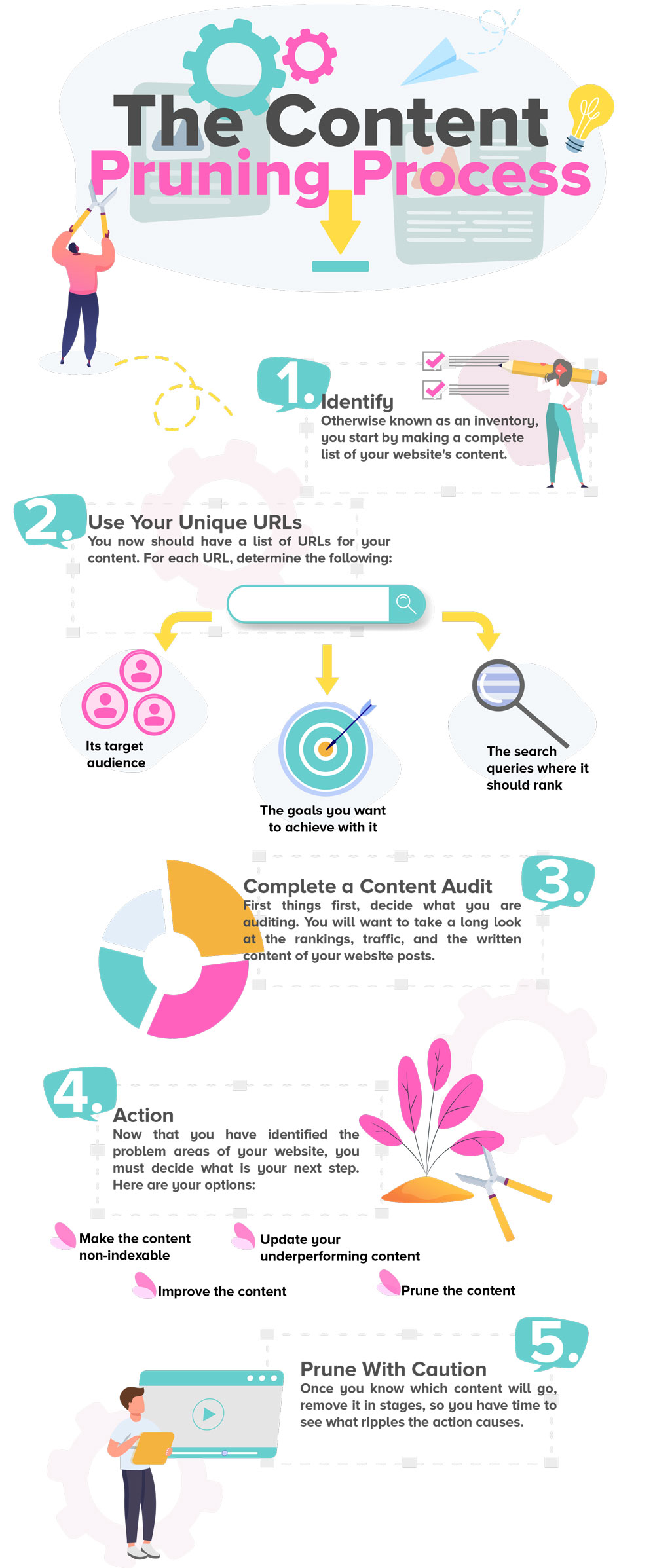For years, the SEO world has put a great deal of energy into content creation. As Google’s algorithms changed, so did the pattern and plan for ideal website content. Now, after years of growing content, it is time for a vital step to keep your website relevant, interesting, and informative.
“Content is king” is a phrase many people have heard, but now, the right type of content is king. You may need to work on content pruning to ensure that your website has the right content.
You may be familiar with the term, as it is not exactly a new idea, but is becoming a more significant and vital force in improving your website’s SEO.
What is content pruning?
Similar to the pruning that takes place in an agricultural setting, content pruning involves taking stock of what you have and removing things that are not producing or, worse, hindering your progress. In the case of content pruning, you are looking for outdated pieces, have thin content, or your company no longer stands behind.
Removing the ‘dead weight’ from your site gives quality content room to grow and stand out. Your content will be easier for visitors to use and understand, and Google bots will be more efficient when crawling your website.
Why is content pruning important?
There are several reasons content pruning is vital to your success.
- Satisfying Google’s core update of 2020 – The update in May of 2020 was a game-changer for many during a time of global chaos. However, the search engine giant’s changes did speak to its growing emphasis on high-quality content, freshness, and E-A-T (Expertise, Authoritativeness, and Trustworthiness) are massively important.
- Offering customers the best you have – It is no secret that you have mere milliseconds to capture your customer’s attention, or they scroll elsewhere. In light of this, it makes sense always to bring your A-game. Content pruning will improve your customers’ user experience, which is vital to Google and your visitors. Additionally, it shows your content matters to you. When your blog posts have little to no use or product pages show items that have changed, it screams a lack of caring on your part.
- Streamline what Google bots need to crawl – Even your older content is crawled regularly. If you have thin or irrelevant content on your site, it will make ranking organically quite difficult. By pruning your content, you show the best version of your site, products, and company.
- Distribute your link authority evenly – When you trim away dead weight, your link authority flows to pages that offer valuable content.
The content pruning process
The process of pruning your content is not complicated. However, it can be a labour-intensive project, especially if you have many pages & blogs to consider. This guide can help as you sift through content and make some hard choices about the future of your content:
- Identify – Otherwise known as an inventory, you start by making a complete list of your website’s content. You can do this yourself or with the help of an app created for such a process.
- Export – Get CMS data from your web analytics tool. You can use an Ahrefs tool to gather backlink data.
- Filter – You will have a number of duplicates that will need to be removed.
- Use your unique URLs – You now should have a list of URLs for your content, and it is time to clarify a few points for yourself and your team. It is easy to be thrown off track, especially if you are dealing with a large amount of content. However, the audit and subsequent decisions will be more straightforward once you complete this. For each URL, determine the following:
- Its target audience
- The goals you want to achieve with it
- The search queries where it should rank
Additionally, while you sort through the individual URLs, ask yourself the following questions:
- Is the content relevant to the brand?
- Does the content speak to business needs or questions the reader may have or guide a reader to an educated decision?
- Has this topic been discussed in other pieces of content, and if so, is it from a similar point of view or does the content cover different aspects of the same topic? For example, if you make and sell dog accessories, you may have a blog post introducing products to retail shops. A separate post can be directed at dog groomers. And a third post could be written to inform pet parents about your products. In this case, each piece makes a valuable point from another direction.
- Should you merge similar topics into a single piece, or is it better to allow the pieces to stand alone?
- Do you have content that can be repurposed? Sometimes, adding timely facts and cleaning up older pieces can breathe new life into content and make it relevant once more.
- Have the changes and choices made improved the user experience?
- Complete a content audit – First things first, decide what you are auditing. You will want to take a long look at the rankings, traffic, and the written content of your website posts. When you perform your audit, start with the information you learned in the earlier steps of this guide. You should have an extensive collection of information that will help you moving forward.You will need to add the following information to what you have collected.
- Organic performance that shows visits and conversions from the past 12 months – The number of visits and conversions is generally found in the Google Search Console and Bing Webmaster Tools, as well as in your web analytics tool.
- General performance showing visits and conversions during the past 12 months – You can usually find the information you need in your web analytics tool. You can use server logs to track performance if you are not tracking your clicks or hosting videos.
- Social performance of content during the past 12 months – You can use your web analytics to track performance in the areas of visits and conversions. Learn the data regarding shares and likes by using a tool such as BuzzSumo.
- The number of internal links and external domains that are linking in-These are easily found in the Google Search Console.
- Check for thin content – Pages with a low word count are generally thought to be thin content pages. However, check the material in the post before you write it off. It is possible that the content is sufficient for the topic at hand.
- Find out if the content is outdated – As stated, old and irrelevant content will do more harm than good, so you will want to keep it at bay. A simple way to check your content is using smart search queries in Google
- Be sure that it is not cannibalising other content – You can spot this by finding pages that are ranking for the same queries and looking for pages that don’t have unique title tags, meta descriptions, and H1 headings.
- Check for over-optimisation – Years ago, over-optimisation was common and considered a good idea. Google eventually said that a piece overflowing with awkward keywords did not represent the search engine’s standards.
- Action – Now that you have identified the problem areas of your website, you must decide what is your next step. Often, the first thought after completing an audit is regarding deleting content. However, you do not need to eliminate every piece of underperforming content. Before removing content, make good use of the URL list you put together. Check each item on the list, calling attention to content that:
- Has poor social media performance
- Is not getting general or organic traffic
- Has few internal and external links
- Is cannibalising other content (we did this for a client of ours, Upscale Business Coaching, and their Google rankings improved dramatically)
- Has thin content
- Has old, outdated information
- Has information that is no longer relevant
Your list of these URLs has the potential to be pruned but consider a few other options first:
- Make the content non-indexable – If you have content that can be useful to a site visitor but holds little SEO value, make the page non-indexable. It will not pop up on the Search Engine Results Pages (SERPs), but it is available to those visiting your website.
- Update your underperforming content – You can accomplish this in several ways.
- Move the Content- Taking content that is informative but not performing well can be reworked into a FAQ section
- Merge with Other Content – Turning several pages that are weak on their own into a single helpful page is generally faster than starting from scratch
- Trim the Content – Instead of totally removing the content, take out parts that do not apply and keep information that is timely and accurate. If you opt to keep older content, be sure you explain this to those visiting your page.
- Improve the content – You may have valuable information that is presented poorly. Before removing content, take a look at it to see if there is any way to salvage it. Try revamping the meta descriptions, titles, or headings to see if it makes a difference. Perhaps on-page SEO can help the content.
- Prune with caution – After moving through these steps, you may feel eager to start deleting and be done with it. You have done the work and made decisions regarding your content. However, there is no rule that says you must cut away every branch in one sitting. Resist the temptation to cut too much all at once. Even though the content pruning process will help your website, you can still feel the impact of cutting content.Your best course of action is, to begin with, the content that is performing the worst. Once you know which content will go, remove it in stages, so you have time to see what ripples the action causes. Then in a few weeks, move on to other content.Using this slow and steady method will help you and your site visitors navigate changes. It also helps with figuring out the next steps based on facts instead of trying to carry out a scorched earth change based on a ‘gut’ reaction. Make a plan of what to do and carry it out methodically. The process will feel more grounded, and you will not need to deal with doubts.
Who is content pruning for?
Suppose you operate a portion or all of your business online and have a website representing your company and the goods and services you provide. In that case, content pruning is something you should consider. This is necessary, particularly if your industry has undergone substantial changes recently.
Things like technological advances, legal changes, or out-of-date ideas are game changers. If your business still features articles about the 2020 toilet paper shortage, you may need pruning.







